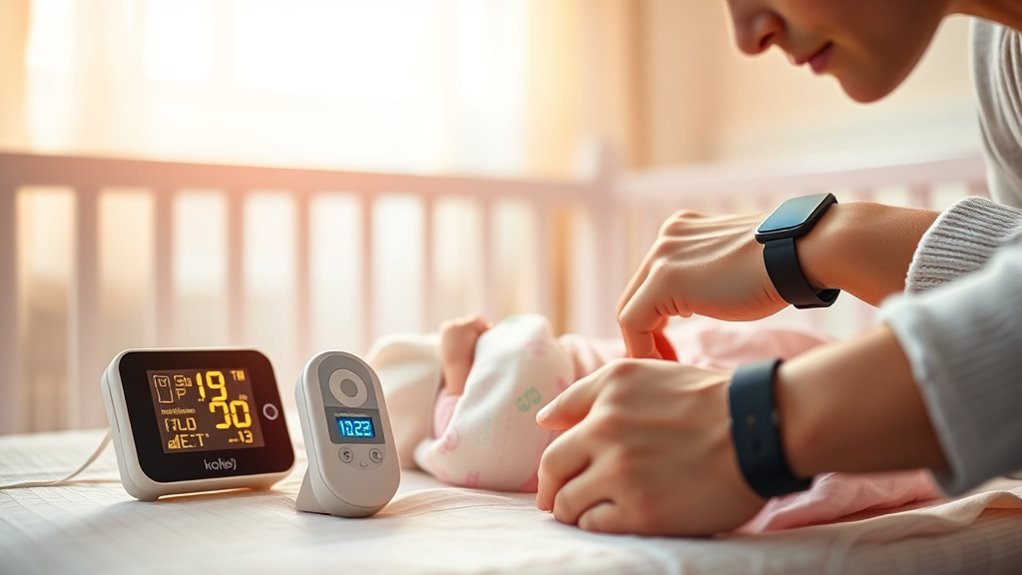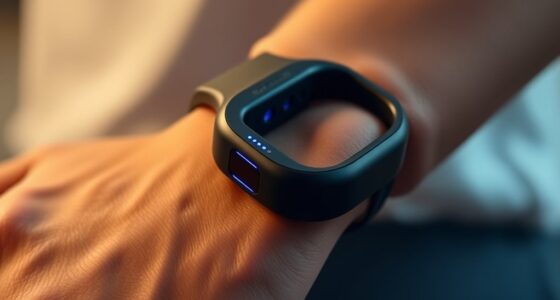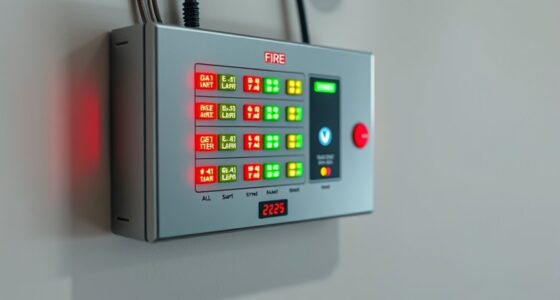The evolution of baby cry monitors for deaf parents started with simple sound detection and sleep analysis, helping you stay connected. It shifted to vibrational alerts for discreet, reliable signals, reducing missed cries. Today, wireless technology and smart home integration let you monitor remotely with personalized notifications and automated controls. Advanced sensors improve accuracy, and future innovations, like environmental sensing and AI, promise even more convenience. If you want to discover how these innovations keep improving your caregiving experience, keep exploring further.
Key Takeaways
- Early baby monitors focused on sound detection and sleep analysis to assist deaf parents in monitoring their infants.
- Transitioned to visual and vibrational alerts, offering discreet, reliable signals for baby cries in noisy environments.
- Integrated wireless technology and smart home systems for remote, secure monitoring with real-time notifications.
- Advanced sensors and calibration techniques improved detection accuracy, reducing false alarms and enhancing customization.
- Future trends include AI analysis, environmental monitoring, and seamless integration with smart devices for proactive caregiving.
Early Innovations in Baby Monitoring for the Deaf

Early innovations in baby monitoring for the deaf emerged out of the need to bridge communication gaps and guarantee parental awareness of their baby’s cries. These devices focused on sound detection, enabling you to be alerted when your baby needed attention, even if you couldn’t hear them. Some monitors incorporated sleep analysis features, helping you understand your baby’s sleep patterns and comfort levels. By analyzing sounds and movement, these early systems provided valuable insights into your child’s well-being. They were simple but effective, offering a way for deaf parents to stay connected and responsive. While basic, these innovations laid the foundation for more advanced monitoring technology, emphasizing the importance of timely alerts and detailed sleep data to ensure your baby’s safety and your peace of mind. Today, monitoring hours are often tailored to accommodate various schedules and needs, further enhancing the safety and convenience of baby care.
Transition From Visual Alerts to Vibrational Devices

As technology advanced, developers shifted their focus from visual alerts to vibrational devices to better serve deaf parents. Vibrational alerts provide a discreet, tangible way to notify you of your baby’s cry, fostering stronger emotional bonding. Unlike visual signals that may be missed if you’re busy or in a noisy room, vibrations offer immediate, reliable parental reassurance. This progression improved the overall child-care experience by reducing anxiety and ensuring you stay connected with your baby’s needs. Vibrational devices also allow for more natural interactions, helping you respond promptly and confidently. Additionally, understanding the importance of color accuracy and contrast ratio in visual signals has helped refine how these devices are designed, making them more effective and user-friendly. As a result, these innovations support a deeper emotional connection between you and your child, making parenting more intuitive and reassuring for deaf parents.
Integration of Wireless Technology and Connectivity

Wireless technology has revolutionized baby cry monitors by enabling seamless connectivity between devices, giving you instant access to your baby’s alerts from anywhere. With this integration, you can monitor your baby remotely, whether you’re in another room or outside the house. To protect your privacy, manufacturers implement wireless security measures like secure Wi-Fi protocols and data encryption, ensuring your sensitive information stays safe. Reliable connectivity minimizes lag and false alarms, providing peace of mind. You no longer need bulky cords or wired setups, making the monitors more portable and easier to install. As wireless technology advances, expect even stronger security features and smoother connectivity, allowing you to stay connected and responsive to your baby’s needs effortlessly. Additionally, Kia Tuning innovations have contributed to more reliable and secure wireless connections in various devices, including baby monitors.
The Rise of Smart Monitors and Mobile Notifications

Smart monitors now use improved wireless connectivity to send real-time alerts straight to your mobile device. With instant notifications, you stay informed about your baby’s needs no matter where you are. They also seamlessly integrate with other smart devices, making monitoring more connected and convenient. Additionally, essential oil benefits can be incorporated into nursery environments to promote relaxation and well-being.
Wireless Connectivity Enhancements
Thanks to advances in wireless connectivity, baby cry monitors now offer seamless integration with smartphones and other devices, making it easier for deaf parents to stay connected. Modern monitors utilize improved wireless protocols, ensuring quick and reliable data transmission. Signal stability is a key focus, reducing dropouts and lag, so you can confidently monitor your baby without interruptions. These enhancements mean your device stays synchronized with your smartphone, providing consistent audio and visual cues. You no longer need to worry about connection issues disrupting alerts. With stronger, more stable signals, you get real-time updates, allowing you to respond promptly. This evolution in wireless connectivity empowers deaf parents to maintain constant awareness of their baby’s needs through more reliable, user-friendly baby cry monitors. Reliable data transmission is essential for ensuring uninterrupted alerts and peace of mind.
Instant Mobile Alerts
As technology advances, baby cry monitors now deliver instant mobile alerts, keeping you informed the moment your baby needs attention. With real-time notifications, you can respond quickly, strengthening parental bonding and providing emotional support even from a distance. These alerts ensure you’re never left guessing about your baby’s needs, fostering peace of mind. Imagine receiving a gentle alert on your phone whenever your baby cries, allowing you to comfort them promptly. Here’s a glimpse of how these monitors work:
| Alert Type | Device | Response Time |
|---|---|---|
| Cry Detection | Smartphone App | Seconds |
| Temperature Alert | Wireless Sensor | Immediate |
| Motion Detection | Smart Watch | Instant |
| Volume Spike | Tablet | Less than a minute |
| Sleep Monitoring | Mobile Device | Real-time |
This technology enhances your emotional connection and supports you in nurturing your little one effectively. Additionally, understanding real-time notifications can help parents better manage their baby’s needs and reduce stress.
Integration With Smart Devices
The integration of baby cry monitors with smart devices has revolutionized how you stay connected to your little one. Modern monitors use wearable sensors to detect even subtle sounds and movements, providing real-time updates on your phone or tablet. Voice recognition technology enhances this connection by distinguishing cries from background noise, ensuring you only receive alerts when necessary. These smart monitors allow you to customize notifications, so you can respond promptly without constantly checking. With seamless app integration, you can monitor your baby’s well-being from anywhere, making it easier for deaf parents to stay informed. Incorporating advanced detection features can further improve accuracy and reliability. This advancement combines technology and convenience, ensuring you never miss a moment or a cry, and fostering peace of mind regardless of your location.
Enhancing Reliability and Accuracy With Advanced Sensors

Advanced sensors considerably improve the reliability and accuracy of baby cry monitors for deaf parents by precisely detecting subtle sound variations. By fine-tuning sensor calibration, the monitors can distinguish between baby cries and background noise, reducing false alarms. Signal processing algorithms analyze these sounds in real-time, ensuring quick and accurate alerts. The table below shows how different sensors and techniques work together:
| Sensor Type | Calibration Method | Signal Processing Feature |
|---|---|---|
| Microphone Array | Regular calibration for sensitivity | Noise filtering algorithms |
| Vibration Sensors | Threshold adjustments | Pattern recognition |
| Acoustic Sensors | Dynamic calibration | Frequency analysis |
| Combined Sensors | Continuous calibration | Adaptive filtering |
This integration ensures your monitor remains dependable, giving you peace of mind. Additionally, incorporating advanced sensor technology helps further enhance detection capabilities in diverse environments.
Incorporating Smart Home Integration for Greater Convenience

Integrating baby cry monitors with smart home systems enhances convenience by enabling seamless control and real-time notifications. With voice recognition, you can effortlessly activate or adjust settings simply by speaking, making it easier to respond quickly. Ambient monitoring features allow your monitor to track room conditions like temperature and noise levels, providing a thorough view of your baby’s environment. When the monitor detects crying, it can trigger alerts directly to your smartphone or smart speaker, ensuring you’re always informed, even when you’re away. This integration streamlines your routines, reduces the need for multiple devices, and helps deaf parents stay connected and responsive. Incorporating wall organization solutions can also help keep your baby’s space tidy and accessible. Overall, smart home integration makes caring for your baby more efficient and less stressful, giving you greater peace of mind.
User-Friendly Designs and Customizable Alerts

You want a baby monitor that’s simple to operate and fits your needs perfectly. With easy-to-use features, you won’t struggle setting it up or maneuvering controls. Plus, customizable alerts let you choose how you’re notified, making it easier to stay connected and respond quickly. Understanding city dynamics can help you select a monitor that suits your environment and lifestyle.
Ease of Use Features
Ease of use is essential when choosing a baby cry monitor for deaf parents, as intuitive design can make a significant difference in day-to-day life. Look for models with voice recognition, which automatically detects your baby’s cries, reducing false alerts and simplifying monitoring. Parental controls should be straightforward, allowing you to customize alert settings easily without complex menus. Clear visual indicators, like flashing lights or vibrations, ensure you notice your baby’s needs quickly. User-friendly interfaces with simple buttons or touchscreens help you operate the monitor confidently, even during stressful moments. The goal is to minimize frustration and maximize reliability, so you can focus on your baby. When features are easy to access and adjust, your experience becomes more comfortable and less stressful.
Personalized Alert Options
Building on the importance of user-friendly designs, personalized alert options elevate the functionality of baby cry monitors for deaf parents. With alert customization, you can tailor notifications to suit your preferences, ensuring you never miss a cry. These monitors offer features like visual cues, vibrating alerts, and customizable sound or light patterns. You can set specific alerts for different types of cries or times of day, making responses more efficient. Personalization helps reduce false alarms and adapts the device to your lifestyle. By choosing personalized alerts, you ensure your monitor works seamlessly with your routine. This level of customization provides peace of mind, knowing you’ll be promptly notified in a way that’s most effective for you and your baby.
Future Trends and Emerging Technologies in Baby Monitoring

As technology continues to advance, baby monitoring devices are becoming more sophisticated and integrated with smart home systems. You can expect upcoming monitors to incorporate brainwave analysis, allowing you to gauge your baby’s sleep quality and stress levels more accurately. Environmental monitoring will also improve, providing real-time data on temperature, humidity, and air quality to guarantee ideal comfort. These innovations will enable you to receive instant alerts through your smartphone or connected devices, even if you’re not in the same room. Furthermore, AI-powered algorithms will interpret data patterns, predicting potential issues before they become urgent. This seamless integration of advanced sensors and smart technology will empower you to respond swiftly and effectively, making parenting safer and more intuitive, especially for deaf parents relying on non-audio cues.
Frequently Asked Questions
How Do Baby Cry Monitors Specifically Cater to Deaf Parents’ Needs?
You’ll find that baby cry monitors cater to deaf parents by using visual alerts like flashing lights or color indicators, ensuring you notice when your baby cries. Tactile feedback, such as gentle vibrations, also alerts you discreetly without sound. These features help you stay connected to your baby’s needs, offering peace of mind and safety. By combining visual and tactile cues, these monitors provide effective, inclusive communication tailored to your specific needs.
What Safety Standards Are in Place for Vibrating and Wireless Monitors?
You should know that safety standards for vibrating and wireless monitors focus on sound sensitivity and vibration feedback. Manufacturers must guarantee these devices emit minimal electromagnetic interference and meet strict safety guidelines to protect your baby. Vibration feedback is designed to be gentle and non-harmful, while wireless signals are regulated for safe transmission. Always check for certifications like FCC or CE to confirm your monitor complies with established safety standards.
Can These Monitors Be Used for Other Types of Emergencies Besides Baby Crying?
Sure, you can use these monitors for more than just baby cries. They’re designed for diverse emergency alerts, alerting you quickly to any urgent situation. You might also use them for security applications, like monitoring a loved one’s safety or detecting intruders. These versatile devices enhance safety, offering peace of mind through prompt alerts, whether it’s a baby’s cry or an unexpected emergency, making them valuable beyond their original purpose.
How Do Smart Home Integrations Improve Monitoring for Deaf Parents?
Smart home integrations enhance monitoring for deaf parents by combining smart home security with alert systems. You receive instant notifications via your devices, reducing parental stress and ensuring you don’t miss important cues like a baby’s cry. These integrations allow you to monitor your home remotely, automate alerts, and even connect with other smart devices, creating a seamless, reliable system that keeps you informed and reassured no matter where you are.
What Are the Privacy Concerns Related to Connected Baby Monitors?
When using connected baby monitors, you should be aware of privacy concerns, especially around data privacy and user consent. These devices collect sensitive audio and video data, which could be vulnerable if not properly secured. Always guarantee you understand how your data is used, stored, and shared. By reviewing privacy policies and giving informed user consent, you help protect your family’s privacy and prevent unauthorized access.
Conclusion
As you navigate the evolving landscape of baby cry monitors, remember they’re more than just devices—they’re the lighthouse guiding deaf parents through the storm of parenthood. Each innovation symbolizes hope, connection, and empowerment, turning silence into a symphony of safety. Embrace these advancements with confidence, knowing they’re shaping a future where every parent feels illuminated and assured. As technology continues to grow, so does your ability to protect and nurture your little one with unwavering certainty.











